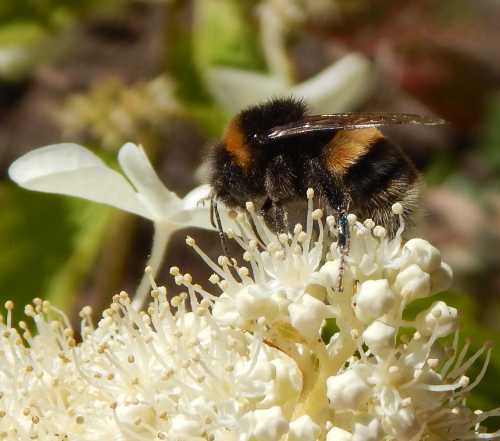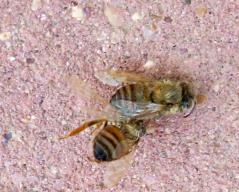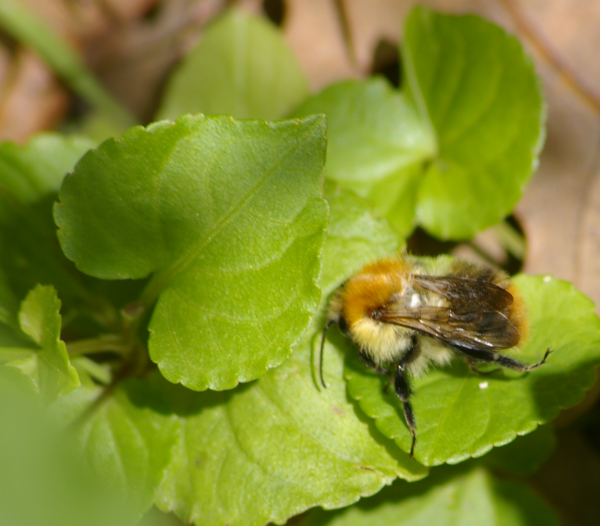Dead Bees
Updated: November 2023
Finding dead bees can cause concern, but
if you have found dead bees in your yard, garden, beneath a tree or
simply on the pavement, there are various possible
explanations.
On this page you will find tips to identify whether the causes are natural or not, and some potential reasons for the death of the bee or bees.
Finding Dead Bees: Questions to consider:
- Which species is it?
- Is it one particular species in one specific location? Or are there several different species of dead bees in the same area (even different species of the same type - e.g. more than one species of bumble bee).
- Are the bees dead in the nest and can any parasites or
strange webbing be seen?
- How many bees are there?
For example, are there thousands
of honey bees or a handful of bumble bees (say 5 to 150?).
- Are the bodies of the bees scattered widely over a large area or all in one place?
- Are there any other dead insects, such as
butterflies, hover flies and so on?
- Is it a single bee that is dead or sleeping?
In considering the above questions, it's also important to note that most bee species have very short life spans, with the exceptions of queens in social bee colonies.
Have you found dead bumble bees?
Most people contact me about seeing dead bumble bees. Usually, the causes are natural.
 Above: Bumble bees are typically rounder, fatter and more furry in appearance than honey bees, although markings may vary
Above: Bumble bees are typically rounder, fatter and more furry in appearance than honey bees, although markings may varySeveral Dead Bumble Bees - Nest cleansing
If there are up to around ten dead bumble bees within a confined area, it could be that there is a nest nearby. Dead bumble bees are cleared out of the nest for reasons of hygiene1.
Individual bumble bees may die in the nest due to being fatally harmed whilst defending the colony against a predator visit. They may also die as they reach the end of their life quite naturally, or through disease.
This clearing out of the nest results in a noticeable handful of dead bees around the same location. Although there will be a nest nearby, you may not have noticed it yet, so have a look around.
Just one dead bee?
Have you found a dead bee (a single specimen), perhaps on the ground or even on a plant? Again, the reasons could be perfectly natural, for example, because of the age of the bee, or due to predator attack or internal parasites or disease.
Some bees can be mistaken for dead, when in fact they are resting or sleeping or resting.
Dead bees around the trunk of a tree
If you find bumble bees with half of the body (head, thorax or abdomen) missing, this is likely down to attack from bird. See Bumble bees with missing head for further explanation.
Alternatively, if
you have found many dead bees around the base of a tree, check whether the tree
is a lime.
To quote an excerpt from 'A Sting In The Tale' by Professor Dave Goulson (also author of Bumblebee Behaviour And Ecology):
Page 128:
"Buff-tailed and white tailed bumblebees love the flowers of lime trees, although there is something in the nectar which seems to make them dopey and even sometimes kill them".
Other Dead Insects, Not Just Bees?
Seeing different insect species dead at the base of a tree, could indicate poisoning.
If you suspect poisoning, I recommend you collect evidence – dead
specimens,
photographs, and any information you can about the use of pesticides at
the
location, then report it to your local authority, or health and safety directorate.
Death of a colony of bumble bees
If you find a whole colony of dead bumble bees – i.e. in the nest, then it is likely that this is due to the invasion of a predator or parasite, and there may be visible signs of this, such as silky webbing (wax moth).
If you come across an infested nest, sadly, there is generally little you can do to help the bees at this stage.
Dead bees along the roadside
It's possible that vehicle collision could cause some casualties. This is covered on my page: dead bumble bees on the roadside.
Dead honey bees?
 Above: Dead honey bees - a link to an explanation of what happened here can be found below. You may also find dead bumble bees or solitary bees.
Above: Dead honey bees - a link to an explanation of what happened here can be found below. You may also find dead bumble bees or solitary bees.Hygienic behaviour
Honey bee colonies are meant to survive the winter (see Where Do Bees Go In Winter.
However, finding a few dead honey bees is perfectly normal. Again, dead bees are automatically removed from the nest or hive as part of hygienic behaviour, which is triggered via a 'death pheromone', which is emitted by dead colony members, and detected by live workers2.
Winter mortality
During the winter, there will usually be more
casualties, and this is known as ‘winter mortality’.
Sometimes, honey bee colonies will succumb to inclement weather conditions during 'cleansing flights' - they leave the hive for a short while, but unfortunately they can get caught out if the weather suddenly turns against them.
Colony collapse disorder
In recent years, beekeepers reported losing around 30% of colonies or more due to colony collapse disorder.
Many countries have a system for recording collapses, and it’s important to record these incidences, and also to consider whether local use of insecticides have weakened the colony.
In summary
Although you may be saddened by the sight of dead bees in your garden or yard, the reasons are often natural. If you suspect other causes, it may a good idea to alert the relevant authorities in your area.
You can help minimise the possibility of harm to bees by avoiding the use of insecticides in and around your garden.
Reference
1. Bumblebees, Their Behaviour and Ecology. Goulson, D. (2003); Oxford University Press, ISBN 0-19-852607-5.
2. McAfee, A., Chapman, A., Iovinella, I. et al. A death pheromone, oleic acid, triggers hygienic behavior in honey bees (Apis mellifera L.). Sci Rep 8, 5719 (2018). https://doi.org/10.1038/s41598-018-24054-2
If you have found a bee and don't know what to do
click here
If you found this page helpful or interesting, I'd really be grateful if you would share it with others - if not this page, perhaps another, such as Gardening For Bees.
Thank you so much :) .
